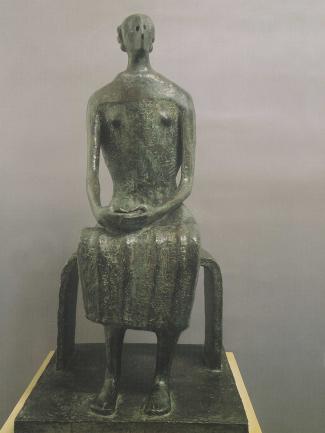The year 1998 marked the centenary of Henry Moore’s birth. The Center paid tribute to the achievement of the single most prominent British artist of the twentieth century with an exhibition dramatically installed in the Entrance Court.
Henry Moore’s career followed a distinctive parabola. The son of a Yorkshire miner, Moore fought at the Western Front in World War I, was gassed at the battle of Cambrai, and was invalided out, all before he was twenty. After receiving a conventional academic training as a sculptor in the early 1920s, he found his own way—partly through visits to Paris and a growing awareness of the avant-garde French art, and partly through visits to the British Museum, where he was deeply moved by the Pre-Columbian carvings of Meso-America. The combination gave his early work great originality and force. Some of the finest examples in American museums were included in this exhibition, from the Philadelphia Museum of Art, the Museum of Modern Art in New York, and the National Gallery of Canada.
World War II marked a turning point in Moore’s work. The shelter drawings showing Londoners finding refuge from the blitz in the Underground echoed the wartime experiences of many Britons. After the war his family groups—often commissioned for public display—similarly reflected the mood of the country. Moore became a regular exhibitor in the official British Council exhibitions abroad. He increasingly worked in bronze and was able to make sculpture in editions which further spread his reputation at home and abroad. The avant-garde artist of the 1930s and participant in international surrealist exhibitions rapidly became a public institution in 1950s and 1960s. Moore received many public commissions, including the monumental carving outside the UNESCO Building in Paris and the huge bronze reclining figure for Lincoln Center in New York.
As his public reception grew, critical estimation of his work cooled. This exhibition aimed to get behind the public sculptor and cultural icon to seek out freshly that which was remarkable and distinctive within his art. It focused particularly on the heroic quality that formed a thread throughout Moore’s work and revealed a tragic underside. Some of his most moving and important sculptures from the postwar period show wounded or fallen warriors and gaunt, emaciated figures who look like survivors from some unknown but terrible event.
View works from the collection included in this exhibition here.
Credits
Jeffrey H. Loria (Yale College, Class of 1962), and his wife Silvia, together with the David T. Langrock Foundation generously supported this exhibition, which was accompanied by a fully illustrated catalogue.
Top image
Visitors in the galleries, Yale Center for British Art, photo by © Elizabeth Felicella / ESTO
Extended reading

Henry Moore and the Heroic: A Centenary Tribute
Edited by Patrick McCaughey